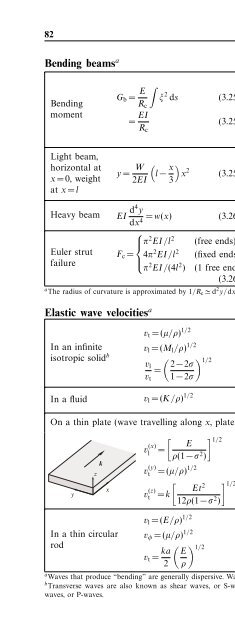You also want an ePaper? Increase the reach of your titles
YUMPU automatically turns print PDFs into web optimized ePapers that Google loves.
82 Dynamics and mechanics<br />
Bending beams a<br />
Bending<br />
moment<br />
Light beam,<br />
horizontal at<br />
x =0, weight<br />
at x = l<br />
Heavy beam<br />
Euler strut<br />
failure<br />
G b = E ∫<br />
R c<br />
ξ 2 ds (3.257)<br />
= EI<br />
R c<br />
(3.258)<br />
y = W (<br />
l − x )<br />
x 2 (3.259)<br />
2EI 3<br />
G b<br />
E<br />
R c<br />
ds<br />
ξ<br />
I<br />
y<br />
W<br />
l<br />
x<br />
bending moment<br />
Young modulus<br />
radius <strong>of</strong> curvature<br />
area element<br />
distance to neutral<br />
surface from ds<br />
moment <strong>of</strong> area<br />
displacement from<br />
horizontal<br />
end-weight<br />
beam length<br />
distance along beam<br />
EI d4 y<br />
dx 4 = w(x) (3.260) w beam weight per<br />
unit length<br />
⎧<br />
⎪⎨ π 2 EI/l 2 (free ends)<br />
F c = 4π<br />
⎪⎩<br />
2 EI/l 2<br />
F c critical compression<br />
(fixed ends) force<br />
π 2 EI/(4l 2 ) (1 free end) l strut length<br />
(3.261)<br />
a <strong>The</strong> radius <strong>of</strong> curvature is approximated by 1/R c ≃ d 2 y/dx 2 .<br />
ds<br />
ξ<br />
neutral surface<br />
(cross section)<br />
x<br />
y<br />
W<br />
free<br />
F c<br />
F c<br />
fixed<br />
Elastic wave velocities a<br />
v t =(µ/ρ) 1/2 (3.262)<br />
In an infinite v l =(M l /ρ) 1/2 (3.263)<br />
isotropic solid b ( ) 1/2<br />
v l 2−2σ<br />
=<br />
(3.264)<br />
v t 1−2σ<br />
v t speed <strong>of</strong> transverse wave<br />
v l speed <strong>of</strong> longitudinal wave<br />
µ shear modulus<br />
ρ density<br />
M l longitudinal ( modulus )<br />
= E(1−σ)<br />
(1+σ)(1−2σ)<br />
In a fluid v l =(K/ρ) 1/2 (3.265) K bulk modulus<br />
On a thin plate (wave travelling along x, plate thin in z)<br />
y<br />
z<br />
k<br />
x<br />
[ ] 1/2<br />
v (x) E<br />
l<br />
=<br />
ρ(1−σ 2 )<br />
(3.266)<br />
v (y)<br />
t =(µ/ρ) 1/2 (3.267)<br />
v (z)<br />
t = k<br />
[<br />
Et 2<br />
12ρ(1−σ 2 )<br />
] 1/2<br />
(3.268)<br />
v (i)<br />
l<br />
v (i)<br />
t<br />
speed <strong>of</strong> longitudinal<br />
wave (displacement ‖ i)<br />
speed <strong>of</strong> transverse wave<br />
(displacement ‖ i)<br />
E Young modulus<br />
σ Poisson ratio<br />
k wavenumber (= 2π/λ)<br />
t plate thickness (in z, t ≪ λ)<br />
In a thin circular<br />
rod<br />
v l =(E/ρ) 1/2 (3.269)<br />
v φ =(µ/ρ) 1/2 (3.270)<br />
v t = ka ( ) 1/2 E<br />
(3.271)<br />
2 ρ<br />
v φ torsional wave velocity<br />
a rod radius (≪ λ)<br />
a Waves that produce “bending” are generally dispersive. Wave (phase) speeds are quoted throughout.<br />
b Transverse waves are also known as shear waves, or S-waves. Longitudinal waves are also known as pressure<br />
waves, or P-waves.


